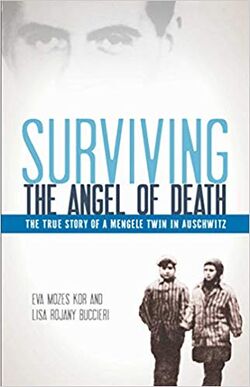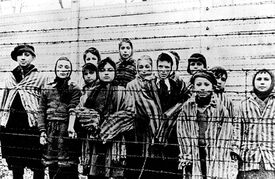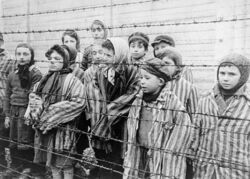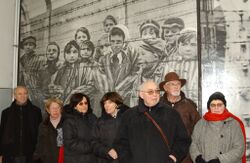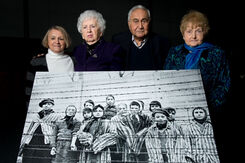Eva & Miriam Mozes (Romania, 1934)
Eva Mozes / Eva Mozes Kor (F / Romania, 1934-2019) and Miriam Mozes (F / Romania, 1934-1993).
- KEYWORDS : <Auschwitz> <Mengele Twins> <Liberation of Auschwitz>
Biography
NOTES : Eva & Miriam Mozes were born in Romania in 1934. In 1944 the family was transported to the Cehel Ghetto and then to Auschwitz. The twin sisters were the only members of the family to survive, as they were selected for medical experiments by Josef Mengele. Their suffering lasts 10 months. Eva and Miriam survived until the camp was liberated on January 27, 1945.
After the war Eva and Miriam went back to Romania with an aunt, who also had survived. In 1950, at age 16, the twins received permission to leave Romania and immigrated to Israel, arriving in the port city of Haifa. Miriam died in 1993, Eva in 2019.
Book : Surviving the Angel of Death (2009)
- Eva Mozes Kor, Surviving the Angel of Death: The Story of a Mengele Twin in Auschwitz (Terre Haute, IN: Tanglewood Pub., 2009).
"Eva Mozes Kor was just ten years old when she arrived in Auschwitz. While her parents and two older sisters were taken to the gas chambers, she and her twin, Miriam, were herded into the care of the man known as the Angel of Death, Dr. Josef Mengele. Subjected to sadistic medical experiments, she was forced to fight daily for her and her twin's survival. In this incredible true story written for young adults, readers learn of a child's endurance and survival in the face of truly extraordinary evil. The book also includes an epilogue on Eva's recovery from this experience and her remarkable decision to publicly forgive the Nazis. Through her museum and her lectures, she has dedicated her life to giving testimony on the Holocaust, providing a message of hope for people who have suffered, and working for causes of human rights and peace."--Publisher description.
Auschwitz Picture
Eva & Miriam are both present in an iconic Auschwitz picture, that depicts 13 child survivors, shortly after the liberation of the camp. All of them have been identified. From left to right they are:
- (1) Tomy Shacham / Tomy Schwarz (M / Slovakia, 1933)
- (2) Miriam Friedman / Miriam Ziegler (F / Poland, 1933)
- (3) Pessa Balter / Paula Lebovics (F / Poland, 1933)
- (4) Ruth Muschkies / Ruth Webber (F / Poland, 1935)
- (5) Bracha Katz / Berta Weinhaber (F / Slovakia, 1930)
- (6) Erika Dohan / Erika Winter (F / Czechia, 1931)
- (7) Marta Wise / Marta Slonim (F / Slovakia, 1934)
- (8) Eva Slonim / Eva Weiss (F / Slovakia, 1931)
- (9) Gabor Hirsch (M / Poland, 1929)
- (10) Gabriel Neumann / Gabriel Nejman (M / Czechia, 1937-2012)
- (11) Shmuel Schelach / Robert Schlesinger (M / Czechia, 1934-2006)
- (12 & 13) Eva & Miriam Mozes / Eva Kor (F / Romania, 1934-2019) and Miriam Zieger (F / Romania, 1934-1993).
Neither Eva nor Miriam (who died in 1993) were among the seven children who reunited on 27 January 2005 in the ceremony in Poland marking 60 years since the liberation of Auschwitz (photograph by Dalit Shacham). The group included (from left to right): Tomy Shacham (1); Erika Dohan (6); Marta Wise (7); Eva Slonim (8); Shmuel Schelach (11); Gabriel Neumann (10); and Bracha Katz (5).
Ten years later, Eva joined three other survivors who gathered in Krakow, Poland on 26 January 2015, at the invitation of the USF Shoah Foundation, on the eve of the 70th anniversary of the liberation of the death camp. The group included (from left to right): Paula Lebovics (3), Miriam Ziegler (2), Gabor Hirsch (9), and Eva Kor (12). (Photo by Ian Gavan/Getty Images).
USF Shoah Foundation
Eva Mozes
Even in a tiny farming village in Romania, the Holocaust found Eva Mozes Kor. Eva, born Jan. 31, 1934, was brought up in a very religious household with two older sisters and her twin sister, Miriam. The Mozes family lived and worked on their large farm in Portz, and they enjoyed a life full of the warmth of family. However, when Hungary annexed the slice of Romania where the Mozes family lived, they faced intense anti-Semitic harassment from students and neighbors. Classmates who were once friends now spit on Eva and called her names. Taunting youth often surrounded the Mozes’ house and threw food and rocks at it for hours. They were the only Jewish family in the village.
Eva and her family were forced to move into the Cehei ghetto in Simleu Silvaniei, Romania, in 1944, where they stayed for about two and a half months. The ghetto had no housing facilities, so the family made a tent out of sheets, which the Nazi commandant would order them to tear down and rebuild in the rain to torment them. In May, they were squeezed onto cattle cars with the rest of the ghetto and sent to Auschwitz. Eva remembers her father saying his morning prayers even as they arrived at the camp.
On the selection platform, Eva and Miriam were immediately recognized as twins and separated from the rest of their family, who was taken to the gas chambers. They were taken with other twins to a special barrack, where Dr. Josef Mengele housed subjects for his medical experiments. When Eva came upon the corpses of three children in the latrine on her first night in Auschwitz, she made a silent pledge to do everything in her power to make sure she and Miriam would not end up on that filthy floor.
Mengele gave the twins injections, drew large amounts of blood, and meticulously measured their body parts and photographed them, often for six to eight hours at a time. One injection left Eva gravely ill. She was separated from Miriam and left to die in the sick ward. She remembers Mengele saying sarcastically, “Too bad, she’s so young—she has only two weeks to live.” Determined to prove Mengele wrong, Eva battled the high fever and five weeks later was reunited with her sister.
That winter, the approaching Soviet Army triggered the Germans to send the majority of camp inmates on death marches to lands that were still under German control. The Soviet Army reached the camp on Jan. 27, 1945, where only the children, elderly, and sick were left behind. Eva and Miriam were first sent to a convent in Katowice, Poland, to recover, and from there traveled with other survivors to Minsk, in the Soviet Union. A woman named Mrs. Csengeri, who had been imprisoned In Auschwitz and was a friend of Eva’s mother and the mother of twins herself, took care of Eva and Miriam until they made it back to Romania and were reunited with an aunt and a cousin. In 1950, Eva and Miriam moved to Israel. Eva served in the Israeli Army for eight years.
Eva married Holocaust survivor Michael Kor in 1960 and joined him in Indiana and had two children, Alexander and Rina. She dedicated herself to raising awareness about Mengele’s Auschwitz medical experiments, and in 1984 she created Children of Auschwitz Nazi Deadly Lab Experiments Survivors (CANDLES) to unite the survivors and lobby for the release of Mengele’s files. In 1995 she founded the CANDLES Holocaust Museum and Education Center in Terre Haute, Ind. That same year, Eva made a profound personal discovery: she had the right and power to forgive the Nazis, though she would never excuse their actions. By exercising this power, she says she freed herself of the burden she had carried for 50 years. Eva still speaks around the country and the world about her experiences, urging healing through forgiveness.
Miriam Mozes
Miriam Mozes Zeiger didn’t have long to enjoy her idyllic childhood on a farm in Portz, Romania. By the time she was ten years old, even school had become a place of torment and oppression.
Miriam lived with her twin sister Eva (both born Jan. 31, 1934), their two older sisters, and parents on a working farm in Portz, a rural village without running water or electricity. They were the only Jews in town and lived a very religious lifestyle. But when Miriam and Eva started school in 1940, the Hungarian occupation had just begun, and anti-Semitism was high. The girls were punished for a prank some boys played on their teacher because they were “dirty Jews” and were spit on and pushed around. Their teacher even showed a movie in class about how to catch and kill Jews.
Though the family tried once to escape Romania (they were caught at the border of their property and forced to return home), they were sent to the Cehei ghetto in Simleu Silvaniei, Romania, in 1944. They stayed there for about 2 ½ months while Nazis tortured their father, who they insisted was hiding gold and silver. All the inhabitants of the ghetto were put on cattle cars and told not to bring any belongings because where they were going, they would have everything they needed.
At Auschwitz, Miriam and Eva were separated from their family and put into Dr. Josef Mengele’s barrack for twins and others who would be subjected to his medical experiments. Miriam and Eva were separated for two weeks, and Miriam was under constant Nazi surveillance while Eva was given injections. Later, they found out that if Eva had died, Miriam would have been killed immediately, as well, so their autopsies could be compared. Over the next nine months, Miriam contracted dysentery and a kidney infection as a result of injections she was given. Yet the two survived.
The approaching Soviet Army triggered the Germans to send the majority of camp inmates on death marches to lands that were still under German control. The Soviet Army reached the camp on Jan. 27, 1945, where only the children, elderly, and sick were left behind. Miriam and Eva recovered at a convent in Katowice, Poland, before making their way back to Romania under the care of Mrs. Csengeri, who had also been imprisoned In Auschwitz and was a friend of Eva’s mother and the mother of twins herself. Miriam and Eva reunited with an aunt and cousin before moving to Israel in 1950.
Miriam studied to be a nurse, married Yekutiel Zeiger, and had three children, Yaffa, Ariella, and Ayala. She also had ten grandchildren. However, she suffered from kidney disease all her life because of Mengele’s experiments. Eva donated a kidney to Miriam in 1987, but Miriam developed cancer and died June 6, 1993.
Additional Bibliography
- Echoes from Auschwitz: Dr. Mengele's Twins: The Story of Eva and Miriam Mozes (1995) with Mary Wright — Template:ISBN
- Surviving the Angel of Death: The Story of a Mengele Twin in Auschwitz (2009) with Lisa Rojany Buccieri — Template:ISBN
- Little Eva & Miriam in First Grade (1994) Eva Mozes Kor - Template:Oclc
